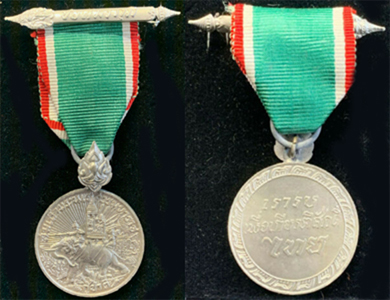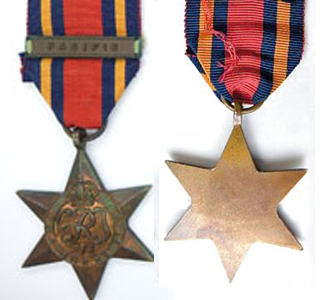Japanese Invade Thailand and Burma
In December 1941, after a Japanese assault that lasted only a few hours, the Thais effectively surrendered to the Japanese. When the Japanese invaded Bangkok they immediately occupied Chinatown (Sampeng) and turned the Chinatown Chamber of Commerce into a command post. The Thais signed a treaty with Japan, allowing the stationing and transit of Japanese troops in exchange for the preservation of Thailand's sovereignty.
China-Burma-India is one of the most forgotten theaters of World War II. As the United States entered the war after Pearl Harbor, it looked to China as a source of manpower as well as a base for bombers and a way to eventually invade Japan. Meanwhile, the Chinese Nationalist (KMT) leader, Chiang Kai Shek looked to Burma Road for supply for the war through the Lend-Lease policy with the United States.
In 1942, the Japanese unexpectedly swept into Burma (then a British colony and now Myanmar) from Thailand. Some Japanese units entered Burma from the jungles of northwestern Thailand. Burma became an important theater for the Pacific Asia War. As World War II raged on, it would bring numerous bloody battles to the cities and jungles of Burma. The Japanese won a string of victories against Chinese and British troops and finally captured the key town of Yenangyaunh. In response, the British destroyed Burmese oil field equipment and set the wells ablaze before withdrawing.
The only seriously resistance against the Japanese in the Indochina campaign was in Burma, where the American Volunteer Group, better known as the Flying Tigers, shot down dozens of Japanese planes. The Tigers flew a hundred P-40 fighter planes that were sent to China after the passage of the Lend Lease Act in April, 1941.
The 38mm silvered-zinc Thai East Asia Combat Service Medal was issued in 1941. It depicts three men on a charging elephant (one driver, one in a covered howdah, and one behind the howdah. The reverse reads WE FIGHT FOR THAILAND'S HONOR.
The Medal was awarded in to members of the Thai Armed Forces who served in the East Asia theater of operations during the Second World War. Following the Japanese invasion on December 1941, the Thai government surrendered within five hours and allowed the transit movement of Japanese Forces through its sovereign territory on their way to attack British Malaya and Singapore. An alliance between Thailand and Japan was formally signed on December 21, 1941 while on January 25, 1942, the Thai government declared war on the United States and Great Britain. After the end of the Second World War, the Allies treated Thailand as a defeated power but in contrary to Japan and Germany they did not occupy the country.

Thai East Asia Combat Service Medal
The Burma Star is a British campaign medal, instituted in May 1945 for award to British and Commonwealth forces who served in the Burma Campaign from 1941 to 1945, during the Second World War. One clasp, PACIFIC, was instituted to be worn on the Burma Star medal ribbon. In the event an individual qualified for both the Burma and the Pacific Star, they would receive the Star first qualified for and either the PACIFIC or BURMA clasp.

UK Burma Star With Bar PACIFIC
The yellow copper/zinc alloy, six-pointed Burma Star measures 44mm X 38mm. The obverse of the star is comparable in design to the 1843 Gwalior Star. The center of the star reflects the Royal Cipher of King George VI, surmounted by a crown overlaid on a circlet which bears the title of the award THE BURMA STAR. The blank reverse of this medal is the same as all the other WWII British Star campaign medals.
In December 1941, after a Japanese assault that lasted only a few hours, the Thais effectively surrendered to the Japanese. When the Japanese invaded Bangkok they immediately occupied Chinatown (Sampeng) and turned the Chinatown Chamber of Commerce into a command post. The Thais signed a treaty with Japan, allowing the stationing and transit of Japanese troops in exchange for the preservation of Thailand's sovereignty.
China-Burma-India is one of the most forgotten theaters of World War II. As the United States entered the war after Pearl Harbor, it looked to China as a source of manpower as well as a base for bombers and a way to eventually invade Japan. Meanwhile, the Chinese Nationalist (KMT) leader, Chiang Kai Shek looked to Burma Road for supply for the war through the Lend-Lease policy with the United States.
In 1942, the Japanese unexpectedly swept into Burma (then a British colony and now Myanmar) from Thailand. Some Japanese units entered Burma from the jungles of northwestern Thailand. Burma became an important theater for the Pacific Asia War. As World War II raged on, it would bring numerous bloody battles to the cities and jungles of Burma. The Japanese won a string of victories against Chinese and British troops and finally captured the key town of Yenangyaunh. In response, the British destroyed Burmese oil field equipment and set the wells ablaze before withdrawing.
The only seriously resistance against the Japanese in the Indochina campaign was in Burma, where the American Volunteer Group, better known as the Flying Tigers, shot down dozens of Japanese planes. The Tigers flew a hundred P-40 fighter planes that were sent to China after the passage of the Lend Lease Act in April, 1941.
The 38mm silvered-zinc Thai East Asia Combat Service Medal was issued in 1941. It depicts three men on a charging elephant (one driver, one in a covered howdah, and one behind the howdah. The reverse reads WE FIGHT FOR THAILAND'S HONOR.
The Medal was awarded in to members of the Thai Armed Forces who served in the East Asia theater of operations during the Second World War. Following the Japanese invasion on December 1941, the Thai government surrendered within five hours and allowed the transit movement of Japanese Forces through its sovereign territory on their way to attack British Malaya and Singapore. An alliance between Thailand and Japan was formally signed on December 21, 1941 while on January 25, 1942, the Thai government declared war on the United States and Great Britain. After the end of the Second World War, the Allies treated Thailand as a defeated power but in contrary to Japan and Germany they did not occupy the country.

Thai East Asia Combat Service Medal
The Burma Star is a British campaign medal, instituted in May 1945 for award to British and Commonwealth forces who served in the Burma Campaign from 1941 to 1945, during the Second World War. One clasp, PACIFIC, was instituted to be worn on the Burma Star medal ribbon. In the event an individual qualified for both the Burma and the Pacific Star, they would receive the Star first qualified for and either the PACIFIC or BURMA clasp.

UK Burma Star With Bar PACIFIC
The yellow copper/zinc alloy, six-pointed Burma Star measures 44mm X 38mm. The obverse of the star is comparable in design to the 1843 Gwalior Star. The center of the star reflects the Royal Cipher of King George VI, surmounted by a crown overlaid on a circlet which bears the title of the award THE BURMA STAR. The blank reverse of this medal is the same as all the other WWII British Star campaign medals.
Website Maintained by Keith Emroll